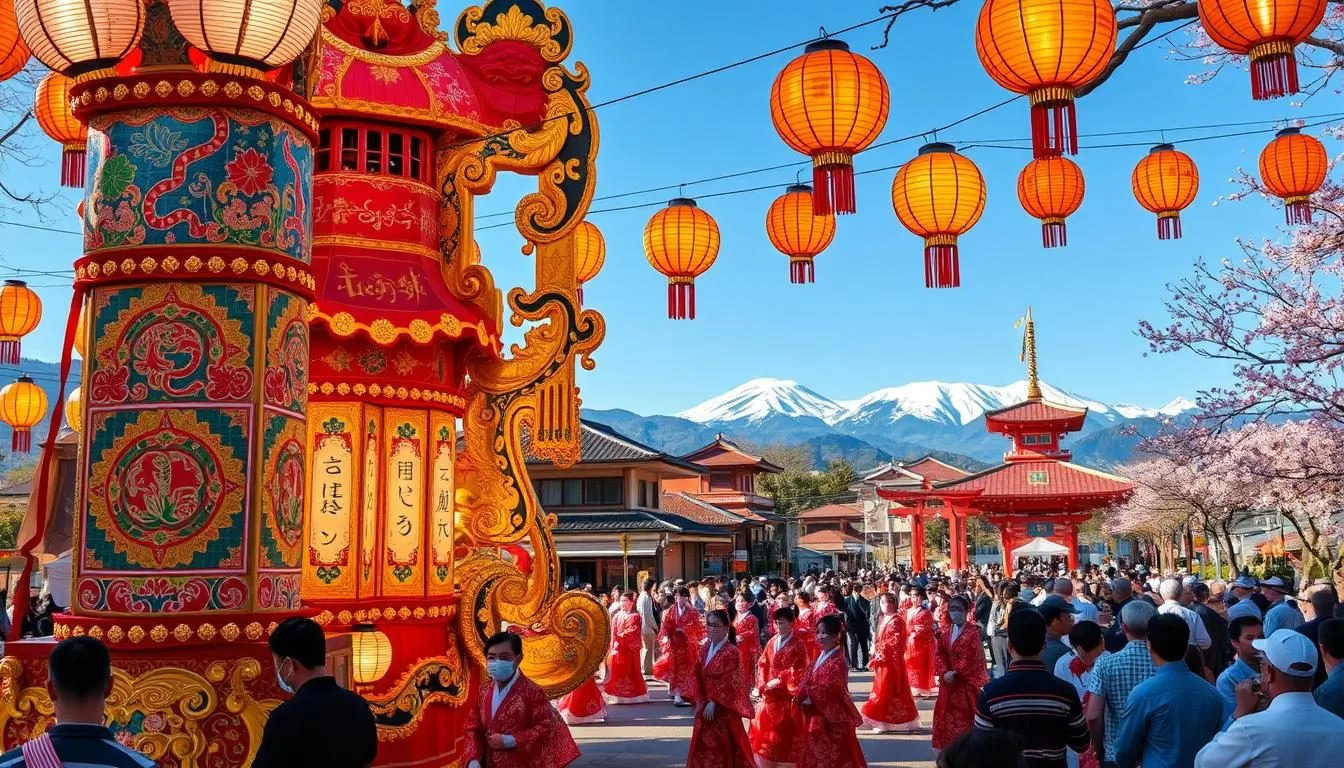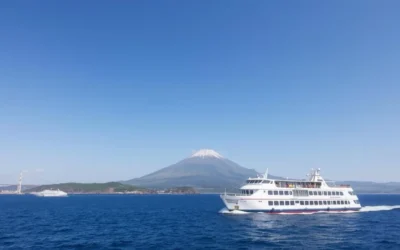✓ Accommodations✓ Flights✓ Rental Cars
Are you planning a trip to Saitama Prefecture? This vibrant cultural destination just outside Tokyo offers a plethora of traditional and modern festivals throughout the year.
Unlike Tokyo’s crowded major events, Saitama’s festivals provide an authentic glimpse into Japanese traditions. This guide will help you plan your visit to coincide with the most spectacular events in the region.
Attending these festivals is one of the best things to do when visiting. You’ll get comprehensive information about seasonal celebrations, from spring cherry blossom festivities to winter illuminations, including dates, locations, and practical tips.
Discovering Saitama’s Rich Festival Culture
The festivals in Saitama are a reflection of the region’s deep-rooted traditions and its connection to Japanese culture. Festivals, or “matsuri,” are an integral part of Japanese heritage, serving as both religious ceremonies and community celebrations. These events have evolved over centuries, often marking important agricultural or celestial occurrences throughout the year.
The Significance of Festivals in Japanese Culture
Festivals in Japan are deeply rooted in the country’s culture, reflecting its strong connection to nature and the changing seasons. They often involve rituals to ensure good harvests, pleasant weather, or to commemorate significant historical events.
What Makes Saitama’s Festivals Unique
Saitama’s festivals stand out due to their unique blend of local customs, traditional foods, and performances. The region‘s natural landscape, including mountains and rivers, provides a picturesque backdrop for many of these celebrations, offering visitors authentic cultural experiences and a glimpse into the area‘s rich heritage.
| Festival Aspect | Description | Significance |
|---|---|---|
| Local Customs | Traditional dances, music, and performances | Preserves cultural heritage |
| Traditional Foods | Local specialties and seasonal treats | Showcases regional cuisine |
| Natural Backdrop | Mountains, rivers, and historic sites | Enhances the festival experience |
Planning Your Festival Visit to Saitama Prefecture
Planning your visit to Saitama Prefecture around its vibrant festivals can be a rewarding experience, offering a glimpse into local culture and traditions. To make the most of your trip, it’s crucial to have the right information.
Best Times of Year for Festival Experiences
Saitama Prefecture hosts a variety of festivals throughout the year. Spring brings cherry blossom festivals, while summer is marked by lively street festivals. Autumn and winter also have their unique celebrations. Understanding the seasonal breakdown helps you plan your visit during festival-rich periods. Before making your plans, remember to verify the dates and details on the official websites, as festival schedules can change.
Transportation Tips for Festival-Goers
Getting to Saitama Prefecture is convenient, thanks to Japan’s efficient train system. You can easily travel from Tokyo and other major cities to various festival sites. Planning your transportation in advance ensures a smooth trip. Consider booking your accommodation near the festival locations to minimize travel time during peak events.
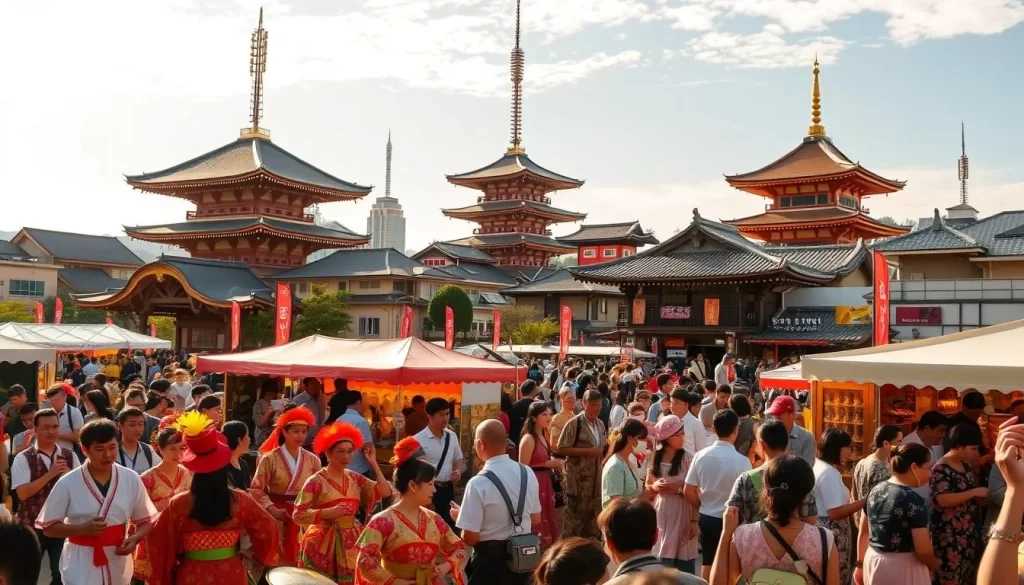
Spring Celebrations: Cherry Blossoms and Renewal
As spring arrives in Saitama Prefecture, the air is filled with the sweet scent of blooming cherry blossoms, signaling the start of the festive season. You can experience the magic of this time of year at various festivals and events throughout the prefecture.
Omiya Hikawa Shrine’s Cherry Blossom Festival
The Omiya Hikawa Shrine’s Cherry Blossom Festival is a highlight of the spring season, transforming the ancient shrine grounds into a popular place for hanami (flower viewing) parties. The streets lined with cherry trees are especially enchanting at night when they are illuminated, creating a breathtaking site to behold.
- Enjoy traditional food stalls and local performances.
- Take part in the traditional hanami parties under the blooming cherry blossoms.
Kitain Temple Spring Festival
The Kitain Temple Spring Festival celebrates the end of winter and the renewal of nature. This historic temple site hosts various ceremonial activities and traditional performances, showcasing the rich cultural heritage of Saitama.
- Experience the unique aspects of the spring festival, including traditional performances and food stalls.
- Visit the sites within the temple grounds to appreciate the historical and cultural significance.
Saitama Prefecture, Japan: Top Festivals to Check Out in Summer
As summer arrives, Saitama Prefecture transforms into a vibrant festival hub, offering unforgettable experiences. The summer festival season is a peak time for celebrations in the area, with numerous events taking place across the region.
Kumagaya Uchiwa Festival
The Kumagaya Uchiwa Festival is one of the region’s most famous summer events, known for its traditional fan decorations and lively performances throughout the city. Visitors can enjoy the music and food available at various stalls, making it a delightful experience.
Chichibu Kawase Festival
The Chichibu Kawase Festival is a significant cultural event that features the unique ritual of washing portable shrines in the river. This festival is a testament to the rich cultural heritage of Saitama Prefecture and offers a fascinating glimpse into traditional Japanese celebrations, often accompanied by fireworks displays at night, turning into a night festival.
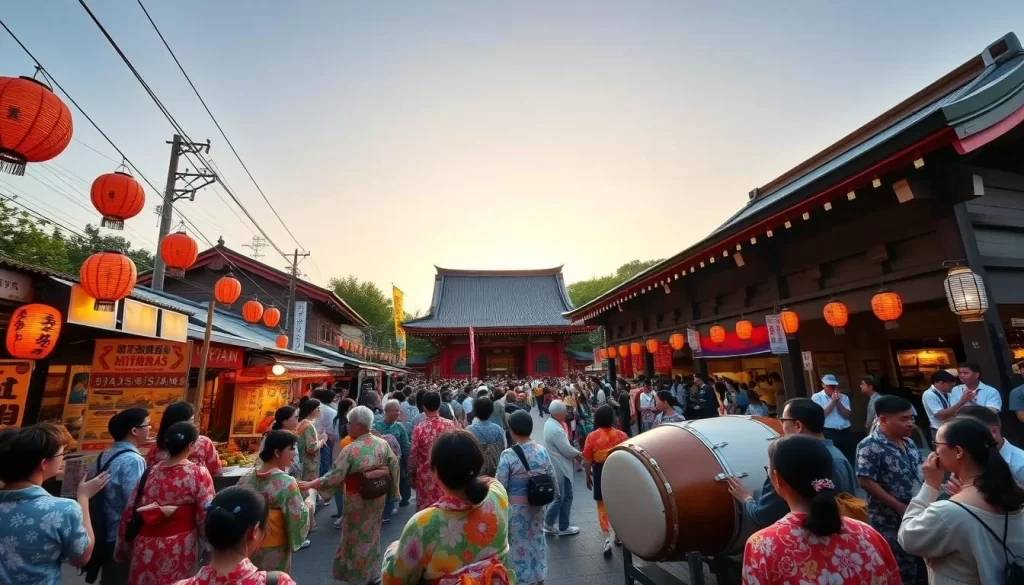
The Spectacular Kumagaya Gion Festival
If you’re planning to visit Saitama during the summer, you shouldn’t miss the Kumagaya Gion Festival, a vibrant celebration that’s steeped in tradition. Known as the largest Gion festival in the Kanto region, it features gorgeous floats, stalls, and lively Kumagaya music.
History and Cultural Significance
The Kumagaya Gion Festival has a rich history dating back to its origins as a religious ceremony to ward off disease. Over time, it has evolved into one of the region’s most spectacular summer events, attracting visitors from all over. The festival is a significant cultural event that showcases the community’s spirit and traditions.
The Famous “Tatakiai” Drum Performances
The highlight of the Kumagaya Gion Festival is the “Tatakiai” drum performances, where participants strike drums and bells with great fanfare. These performances are not only energetic but also competitive, showcasing the performers’ techniques and rhythms. The “Tatakiai” is a sight to behold, filling the atmosphere with excitement and music.
The festival transforms the city of Kumagaya, bringing its streets alive with music, food stalls, and a celebratory atmosphere. The evening components include a spectacular fireworks display that lights up the summer night sky. For travelers, the festival offers a unique experience, with various activities to enjoy throughout the day.
- Explore the festival’s rich history and cultural significance.
- Enjoy the impressive floats and stalls.
- Experience the lively “Tatakiai” drum performances.
- Witness the spectacular evening fireworks display.
Honjo Gion Festival: A 300-Year Tradition
The Honjo Gion Festival is a cherished summer tradition in Saitama Prefecture, boasting a rich 300-year history. It began as a ritual to ward off plague and disease at Yasaka Shrine.
The Daicho Lion Dance: An Intangible Cultural Asset
The Daicho Lion Dance is the festival’s centerpiece, designated as an Intangible Folk Cultural Asset of Saitama Prefecture. This traditional dance is significant to local heritage and culture.
Mikoshi Processions and Community Participation
The festival features elaborate mikoshi (portable shrines) processions through the city streets, made possible by active community participation. This tradition connects multiple generations with their cultural history.
| Key Elements | Description | Significance |
|---|---|---|
| Daicho Lion Dance | Traditional dance performed during the festival | Intangible Folk Cultural Asset |
| Mikoshi Processions | Portable shrines carried through city streets | Community participation and cultural heritage |
| Yasaka Shrine | Origin of the festival | Historical significance |
Satte Festival: Centuries of Heritage
As summer arrives, the town of Satte comes alive with its historic festival, a spectacle not to be missed. With over 300 years of history, the Satte Festival is a cherished event that showcases the town’s rich cultural heritage.
The Seven Decorated Floats Parade
The Satte Festival is renowned for its seven elaborately decorated floats that parade through the streets of the town. Each float is adorned with intricate carvings and decorations that symbolize various aspects of Japanese culture. The craftsmanship involved in creating and maintaining these floats is a testament to the community’s dedication to preserving its traditions.
- The floats are decorated with carvings that depict mythological creatures and historical scenes.
- The decorations are not only aesthetically pleasing but also carry significant cultural meanings.
- The floats are a central attraction, drawing visitors from across the region.
Children’s Portable Shrines and Cultural Significance
A unique aspect of the Satte Festival is the procession of children’s portable shrines. This tradition involves younger generations in the preservation of cultural heritage, teaching them the importance of community and tradition. The portable shrines are carried through the streets, accompanied by festivities and celebrations.
The festival culminates in a contest where teams demonstrate their strength and coordination by maneuvering the floats, followed by a ‘handover ceremony’ that symbolizes the passing of traditions to the next generation.
The festival atmosphere is electric, with food stalls lining the streets and offering a variety of seasonal specialties and local delicacies. Visitors can enjoy traditional shopping opportunities, making the event a significant economic boost for the town.
For the best experience, visitors should position themselves along the main parade route to witness the floats and portable shrines up close. The festival is a perfect blend of tradition, community spirit, and summer festivity, making it a must-visit event in Saitama Prefecture.
Chichibu Shrine Summer Festival
Experience the Chichibu Shrine Summer Festival, a highlight of Saitama’s cultural calendar. This significant spiritual celebration is centered around the historic Chichibu Shrine site and offers a unique blend of traditional rituals, vibrant floats, and cultural performances.
Kasaboko and Yatai Floats
The festival features a parade of kasaboko and yatai floats through the streets during the day. These floats are not only visually stunning but also rich in cultural significance. Decorated with intricate designs and historical figures, they represent various aspects of Japanese mythology and history.
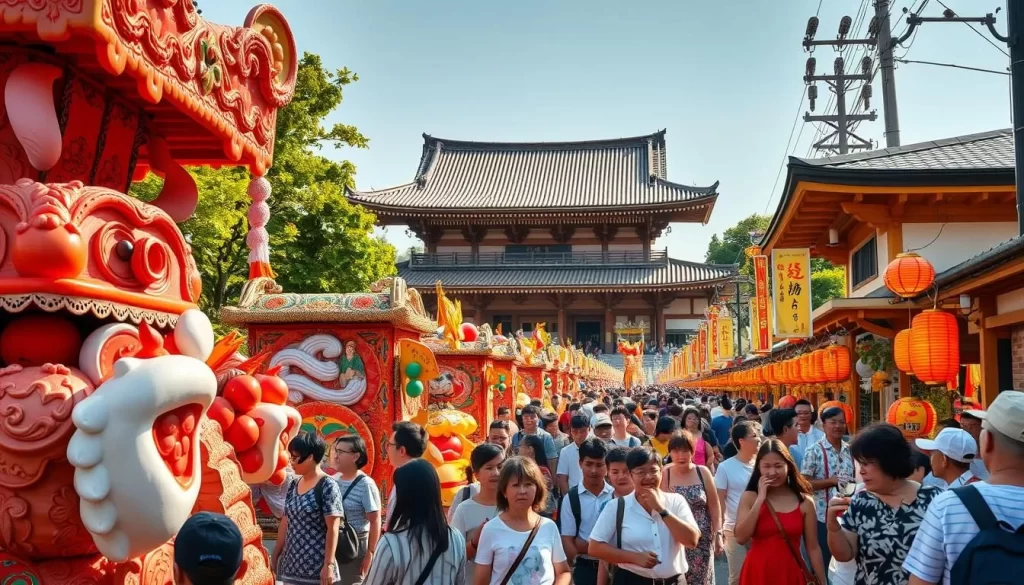
The Sacred Mikoshi-Awai no Shinji Ritual
The highlight of the Chichibu Shrine Summer Festival is the Mikoshi-Awai no Shinji ritual, where portable shrines are ceremonially purified in the clear waters of the Arakawa River. This sacred ritual is a deeply spiritual experience, symbolizing the cleansing and renewal of the community’s spiritual energies.
As the day progresses into night, the festival transforms with the lighting of lanterns, marking the beginning of the night festival. The atmosphere becomes even more enchanting, with musical performances accompanying the various rituals and processions. Traditional instruments and songs, passed down through generations, add to the festive ambiance.
During the festival, you can also indulge in special foods that are available at various stalls. These seasonal specialties are not only delicious but also hold cultural significance, making them a must-try during your visit.
| Event | Time | Location |
|---|---|---|
| Kasaboko and Yatai Floats Parade | Daytime | Streets around Chichibu Shrine |
| Mikoshi-Awai no Shinji Ritual | Afternoon | Arakawa River |
| Night Festival | Evening | Chichibu Shrine grounds |
To make the most of your visit, it’s advisable to plan ahead. Identify the best viewing sites for the main processions and rituals. Arriving early will ensure you secure a good spot to witness the festivities.
Tanabata Festivals Across Saitama
Tanabata festivals in Saitama Prefecture are a spectacle of color, music, and community spirit. Celebrated across different towns, these festivals bring people together, creating a unique and unforgettable experience.
Colorful Decorations and Wish-Making Traditions
The Tanabata festival, known for its vibrant decorations, is a time when the sky is said to be filled with the magic of star-crossed lovers. You can enjoy colorful paper streamers and lanterns that adorn the bamboo branches, where visitors hang their wishes. This wish-making tradition is central to the festival, allowing you to participate in a meaningful cultural experience.
Local Variations and Community Celebrations
Across Saitama, Tanabata is celebrated with local variations that reflect the unique character of each community. You can experience the different traditions and community celebrations, from the display of elaborate decorations to the sharing of special food. The festivals are a testament to the strong community bonds and the rich culture of Saitama.
During the summer season, the Tanabata festivals come alive with music and performances that enhance the festive atmosphere. You can enjoy traditional songs and contemporary performances, adding to the joy and vibrancy of the celebrations. The connection to nature and celestial phenomena is also a significant aspect, reflecting ancient agricultural traditions and the passing of the years.
Fall Festivals: Celebrating Harvest and Heritage
As autumn descends upon Saitama, the region transforms into a vibrant tapestry of festivals celebrating harvest and heritage. The fall season brings a unique charm to the area, with the changing foliage providing a picturesque backdrop to the various events.
Kawagoe Festival: Historic Floats and Performances
The Kawagoe Festival, with its 360+ year history, is a highlight of Saitama’s autumn celebrations. This historic event features elaborate floats, each intricately decorated and housing a doll representing a legendary figure. The floats are paraded through the historic streets, accompanied by traditional hayashi music and performances.
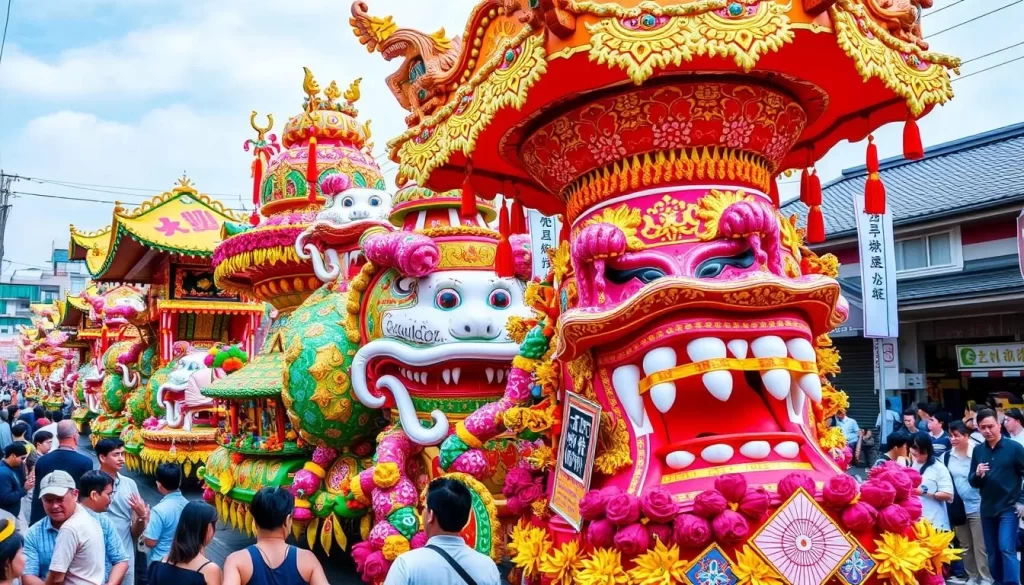
Autumn Food Festivals and Cultural Experiences
Autumn in Saitama is also a time for harvest-themed food festivals, showcasing the region’s seasonal ingredients and local culinary traditions. Visitors can sample a variety of seasonal foods and drinks, experiencing the rich flavors of the area’s agricultural bounty. These festivals connect modern city dwellers to their agricultural heritage and historical traditions.
By participating in these autumn festivals, you can immerse yourself in Saitama’s cultural heritage, enjoying the music, food, and performances that define the region’s identity. Whether you’re watching the float processions, sampling local delicacies, or engaging in festival activities, you’ll experience the warmth and hospitality of the local community.
Winter Illuminations and New Year Celebrations
The cold winter months in Saitama Prefecture are warmed by the dazzling displays of winter illuminations and the rich cultural heritage of its New Year festivities. As you visit during this time, you’ll be treated to a unique blend of traditional and modern celebrations.
Chichibu Night Festival: UNESCO Intangible Cultural Heritage
The Chichibu Night Festival, or Chichibu Yomatsuri, is a standout event, recognized by UNESCO for its cultural significance. This night festival features a spectacular procession of illuminated floats, intricately decorated with lanterns, which are pulled through the streets, creating a breathtaking spectacle.
New Year Shrine Visits and Winter Illuminations
Saitama’s major shrines and temples are bustling during the New Year (hatsumode), with visitors coming to pray and participate in traditional rituals. Additionally, the prefecture’s parks, streets, and public spaces are transformed with millions of LED lights during the winter illumination events, creating a magical atmosphere.
These winter festivals not only provide a warm, festive atmosphere during the coldest months but also bring communities together. Whether you’re watching the fireworks display at the Chichibu Night Festival or strolling through the illuminated streets, Saitama’s winter celebrations are an unforgettable experience.
Local Food Specialties at Saitama Festivals
During Saitama’s festivals, the streets come alive with a variety of traditional and regional foods. As you explore the different festivals throughout the year, you’ll discover a rich culinary landscape that reflects the local culture and traditions.
Traditional Festival Foods You Must Try
Saitama’s festivals offer a range of traditional foods that are both delicious and culturally significant. Some must-try dishes include yakisoba, takoyaki, and chocolate-covered bananas. These foods are not only popular among locals but also offer visitors a taste of the region’s culinary heritage.
Regional Delicacies and Seasonal Treats
The region’s unique delicacies, such as kakigori (shaved ice) in the summer and warming oden in the winter, showcase the seasonal ingredients and culinary creativity of Saitama. Visitors can enjoy these seasonal treats while experiencing the local culture.
Here’s a look at some of the local food specialties you can find at Saitama festivals:
| Food Item | Season | Description |
|---|---|---|
| Yakisoba | Year-round | A popular Japanese noodle dish, often served at festivals. |
| Takoyaki | Year-round | Crispy battered balls filled with octopus, typically served with sauce and bonito flakes. |
| Kakigori | Summer | A refreshing dessert made from shaved ice and flavored syrups. |
| Oden | Winter | A warm, comforting dish made with various ingredients such as fish cakes and boiled eggs. |
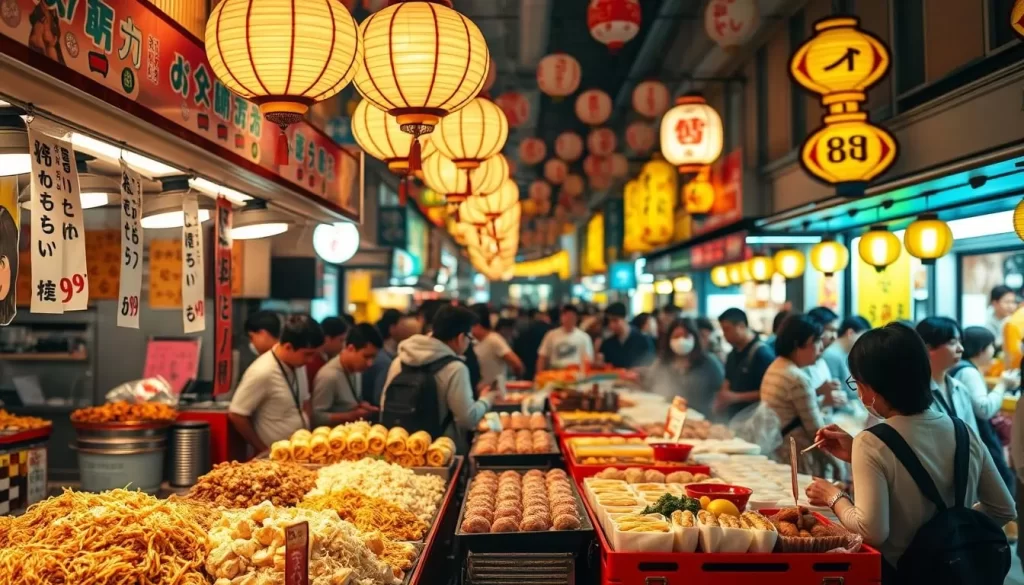
To make the most of your food experience at Saitama festivals, consider the following tips: look for popular food stalls, be prepared for crowds, and don’t hesitate to try new dishes. Most festivals are accessible by train from major cities, making it easy to plan your trip.
Participating in Festival Activities
Saitama Prefecture’s festivals are not just spectacles to watch, but experiences to participate in. By joining in, you can gain a deeper understanding of Japanese culture and create lasting memories of your visit.
Hands-on Experiences for Foreign Visitors
Visitors to Saitama’s festivals can enjoy a variety of hands-on experiences. Many festivals offer traditional craft workshops where you can learn local skills, such as making festival decorations or traditional Japanese crafts. You might also have the chance to join in traditional dances or musical performances, allowing you to engage with the local community and learn about Japanese traditions. Some festivals even provide opportunities to help carry portable shrines, a truly immersive cultural experience.
Etiquette and Cultural Considerations
When participating in Saitama’s festivals, it’s essential to be mindful of local culture and customs. Be respectful at religious sites and during ceremonial activities. Learning a few key Japanese phrases can enhance your experiences and interactions with locals. Understanding and respecting these aspects will allow you to fully enjoy the festivals and make the most of your day.
| Festival Activity | Description | Location |
|---|---|---|
| Traditional Craft Workshops | Learn local crafts and make festival decorations | Various Festivals |
| Traditional Dance Performances | Join in local dances and engage with the community | Kumagaya Uchiwa Festival, Chichibu Kawase Festival |
| Carrying Portable Shrines | Participate in carrying mikoshi during festivals | Honjo Gion Festival, Satte Festival |
Photography Tips for Festival Visitors
When visiting Saitama Prefecture, capturing the essence of its vibrant festivals through photography can be a truly rewarding experience. To help you make the most of your visit, here are some specialized photography tips for capturing the colors, movement, and energy of these events.
Capturing the Colors and Energy of Matsuri
To capture the vibrant colors and dynamic energy of Saitama’s festivals, consider using a camera with good burst mode and autofocus capabilities. Fast shutter speeds are ideal for freezing the motion of floats and participants. Don’t forget to experiment with different angles and compositions to add variety to your shots. For instance, getting low to the ground or climbing to a higher vantage point can provide unique perspectives on the festival action.
Best Vantage Points and Timing
Identifying the best vantage points and timing is crucial for capturing stunning festival photos. Look for elevated locations such as balconies or hills that offer a clear view of the festival area. The “golden hours”—just before sunset and after sunrise—provide soft, warm light that can enhance your photos. Additionally, be prepared to capture key moments during the festival, such as the lighting of lanterns or the launch of fireworks displays at night.
When photographing festival participants, be respectful and considerate. In some cases, it may be necessary to ask permission before taking someone’s picture. Be mindful of any photography restrictions at certain places or during specific ceremonies, and always prioritize the comfort and privacy of those around you. For food photography, consider the lighting and composition to make your dishes visually appealing.
Accommodation Tips During Festival Seasons
The excitement of Saitama’s festivals is undeniable, but so is the need to book your accommodation well in advance. As festival dates approach, Saitama Prefecture becomes a hotspot for travelers, and the demand for lodging increases significantly.
Where to Stay for Major Festivals
Choosing the right area to stay in Saitama can greatly enhance your festival experience. For major festivals like the Chichibu Night Festival, consider staying in Chichibu city for proximity to the event. For other festivals, areas with good train connections to the festival sites are advisable.
- Stay in the city where the festival is held for convenience.
- Opt for areas with easy access to public transportation.
- Consider the proximity to food stalls and local amenities.
Booking Strategies for Peak Festival Times
To secure the best accommodation, it’s crucial to book early. Here are some strategies:
- Book your accommodation at least 3-6 months in advance.
- Consider alternative accommodations like guesthouses or ryokans.
- Look for hotels or lodgings that offer shuttle services to festival sites.
| Festival | Recommended Area to Stay | Transportation Tips |
|---|---|---|
| Chichibu Night Festival | Chichibu City | Use special event buses or trains. |
| Kumagaya Uchiwa Festival | Kumagaya City | Stay near JR Kumagaya Station for easy access. |
| Omiya Hikawa Shrine’s Cherry Blossom Festival | Omiya, Saitama City | Use JR lines to reach the shrine. |
When deciding between staying in Saitama or commuting from Tokyo, consider your priorities regarding convenience, cost, and cultural immersion. Saitama offers a more immersive experience, while Tokyo provides a wider range of accommodation options.
For summer festivals, amenities like air-conditioned spaces or proximity to bathing facilities can be particularly valuable. Always verify the festival dates and accommodation details on official websites to ensure a smooth trip.
Conclusion: Embracing the Festival Spirit of Saitama
From spring to winter, Saitama’s festivals offer a captivating glimpse into the region’s history, culture, and natural surroundings. You can experience a diverse range of festivals throughout the year, showcasing the region’s rich heritage.
By participating in these festivals, you’ll gain a deeper connection to Japanese culture and create lasting experiences. Saitama’s celebrations blend reverence for nature, community spirit, and artistic expression, making them a unique experience. Whether you’re visiting for one year or many years, Saitama’s festivals will leave a lasting impression, inviting you to embrace the festival spirit.
The above is subject to change.
Check back often to TRAVEL.COM for the latest travel tips and deals.
